Arc flash has and continues to be an issue for our industry. All you need to do is speak with someone who has survived an arc flash event or look at the statistics to understand the magnitude of impact these events have on not only that person who may have survived but also on everyone else either directly or indirectly involved; at work and at home. This is a problem in our industry that happens all too often but I firmly believe that these events can and should be things of the past. We have the technology and work practice knowledge to take a bite out of the statistics of arc flash, and NEC 2014 is making great strides in the right direction.
Background
Surprisingly, after a search for a definition of the term arc flash, I could not find a formal definition in IEEE, NFPA or other similar publications. These documents define arc flash boundary, arc flash incident energy, arc flash hazard and other similar terms but not arc flash. So I am taking a liberty here to provide a definition that I have put together based on reading many different documents relating to arc flash and arc flash energy. “An arc flash is the light, heat, sound and gases produced as a result of a rapid release of energy due to an arcing fault sustained by the establishment of highly conductive plasma.” The severity of the event is not in the definition above as that aspect of an arc flash event is addressed by some of the other definitions above which address boundaries and incident energy.
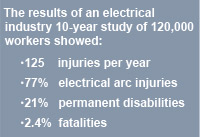
Figure 1. Arc Flash Statistics
Arc flash incidents occur all too often and impact many lives; the remnants of the event may last forever. Figure 1 is a small peek into the problem. It illustrates statistics around a survey of 120,000 workers. These events can be violent, yielding temperatures as high as 20,000°C and forces in excess of 100kPa (Kilopascal). In addition to temperatures and pressures, there may be flying debris that also can do an extensive amount of damage.
The plasma mentioned in our definition of arc flash, amongst other things, introduces impedances that work to reduce the three phase fault current to a lower value of arcing current: “A fault current flowing through electrical arc plasma, also called arc-fault current and arc current.” 1

Figure 2. Breaker response time for a bolted fault current. Note the very fast clearing time removes the fault reducing arc-flash energy.
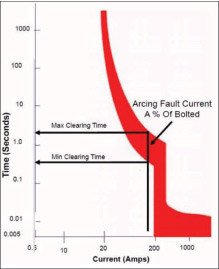
Figure 3. Breaker response time for an arcing fault current which is of a magnitude less than the calculated bolted fault current. Notice you are in the overload region of the trip curve and your clearing times are much longer resulting in a lot more energy.
Arcing current can be significantly lower than the calculated three-phase bolted fault. This lower value may be lower than the instantaneous pickup of the overcurrent protective device which would mean that the arcing current could be permitted to flow for a long period of time. To illustrate this, figures 2 and 3 include the time current characteristic (TCC) curve of a standard thermal magnetic circuit breaker. Figure 2 shows a calculated bolted fault value that falls above the instantaneous pickup and in the instantaneous region of the overcurrent protective device. Figure 3 illustrates that the arcing current is a percentage of the bolted fault current that in this case falls below the instantaneous pickup of the overcurrent protective device.
This response time results in an arcing current that is permitted to flow from approximately 0.5 second to 3 seconds which happens to be a very long time when you consider energy is time multiplied by the square of current. This illustrates why an arcing current downstream of an overcurrent protective device can do a lot of damage before a device trips. For an example such as that shown in Figure 2, some other means would have to be put in place to address the arcing fault and clear it in a shorter amount of time.
Arc flash events can be caused by metallic tools, test probes, loose equipment parts, or similar items coming in contact with energized bare parts creating a short circuit. Other sources have been known to include the misapplication of test instruments as test instruments applied beyond their listing. To address the problem in the industry we turn to codes and standards. A peek into the activity in this area illustrates the type of attention arc flash is getting by the electrical industry.
Electrical Codes / Standards
When I think about arc flash and codes and standards, two key documents come to mind; NFPA 70 National Electrical Code and NPFA 70E Standard for Electrical Safety in the Workplace. These documents work together to help reduce the incidents of arc flash, in addition to many other hazards.
The key thing that separates these two documents is how they are enforced. NFPA 70 is familiar to many, enforced by electrical inspectors across the country, used as an installation requirement by many electrical contractors across the country and in the design process by many professional engineers across the country. It is an installation requirement that is adhered to and enforced at the early stages of the development of a structure. This document includes such requirements as GFCI, AFCI, equipment ground fault and grounding/equipment bonding which all act to prevent a problem from occurring or work to mitigate the effects of events should they occur. The systems installed per the NEC are later maintained by many in the industry.
NFPA 70E, on the other hand, is not enforced in the same manner. This document is primarily enforced by OSHA and usually after an event occurs. Recently though, OSHA has been enforcing workplace safety practices during routine inspections. In my mind, when it comes to stopping the problem before it occurs, NFPA 70 is the document that has the most impact.
With respect to arc flash, the NEC has not historically been very active until just recently. Section 110.16, Arc-Flash Hazard Warning, was the first introduction of the term arc-flash to the NEC. It was introduced in the 2002 version of the Code and is a requirement for a sign that raises awareness of the hazard. Signs are great ways to raise awareness of hazards but implementing technologies that act to mitigate the problem is a more direct way to address the issue.
NEC 2012 took a more direct approach in the fight against arc flash. This document introduced a new section 240.87, Noninstantaneous Trip, intended to specifically target the arc flash issue. Controversial as any other big change, this new section came in with one proposal (Proposal 10-82) and many comments (Comments 10-36, 10-37, 10-38, 10-39, 10-40, 10-41, 10-42, 10-43, and 10-44). Figure 5 illustrates the language that was decided upon for 240.87 and which can be found in NEC2011. This language was met with many questions. For example, the phrase “utilized without an instantaneous” came under fire by some in the industry as it was debated whether or not simply having instantaneous trip capabilities on the breaker, even when turned off, was enough to meet the intent of the code. But as with many sections of the NEC, time will help this section get better.
The 2014 cycle of the NEC offered another opportunity for public input. The Proposal phase of NEC 2014 saw 7 proposals on section 240.87 of the Code (10-53a, 10-54, 10-55, 10-56, 10-57, 10-58, and 10-59). The Comment phase brought out 10 comments (10-20, 10-21, 10-22, 10-23, 10-24, 10-25, 10-26, 10-27, 10-28, and 10-29). The panel settled on a language that is not only crystal clear for the inspector but will also have a considerable impact on the arc flash problem. The 2014 language, as gathered from ROP and ROC documents, is shown in figure 6. Note that the final published version of the NEC may have some minor changes but this should get you in the ballpark. The new language has removed any ambiguity of where this section applies. I will add that the technologies outlined in this section can be applied below 1200 amps as well.
The code panel utilized language from section 230.95 of the NEC when creating what we will soon see as the new Section 240.87. Section 230.95 states “. . . The rating of the service disconnect shall be considered to be the rating of the largest fuse that can be installed or the highest continuous current trip setting for which the actual overcurrent device installed in a circuit breaker is rated or can be adjusted.” With minor modifications, this language served the panel well in that the language is familiar to the inspector and installer. Good code is clear, concise and familiar. This new section is just that.
Arc Reduction Technologies
There are four technologies included in this section plus a provision that permits the application of an approved equivalent. Let’s talk briefly about each of these technologies and we’ll focus a little more on the approved equivalent later.
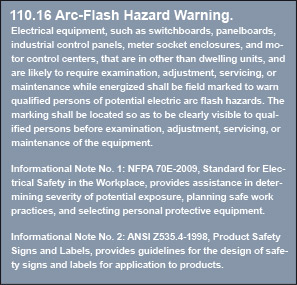
Figure 4. Section 110.16
Zone Selective Interlocking (ZSI)
A circuit breaker equipped with zone selective interlocking provides a method to reduce fault clearing times should a fault occur while working on energized circuits within the zone of protection (between the upstream and downstream pair of circuit breakers). The reduced clearing times greatly reduce arc flash energy.
Zone selective interlocking utilizes a communication signal between two or more trip units applied on upstream and downstream pairs of breakers that have already been selectively coordinated. During fault conditions, each trip unit that senses the fault sends a restraining signal to all upstream trip units. When the upstream trip unit sees this restraining signal, it will remain closed while the downstream breaker clears the fault. In the absence of a restraining signal, when the fault is between the two trip units, the upstream trip unit ignores its programmed settings and trips with no intentional time delay, reducing the clearing time, minimizing damage at the fault point and reducing the arc flash energy.
Differential Relaying
Differential relaying is very similar to zone selective interlocking in that it is able to determine if a fault occurs within a particular zone of protection, reduces the clearing time, minimizes damage at the fault point and reduces the arc flash energy. It is different in that it monitors the amount of current going into and out of a zone of protection. If the amount of current going into the zone is greater than the amount of current flowing out of the zone, then the device knows that the fault is within the zone and acts to open the circuit with no intentional delay. If the current going into the zone and the current going out of the zone are equal there is no fault within the zone, so the circuit breaker does not trip.
Energy Reducing Maintenance Switch
A circuit breaker equipped with an arc flash reduction maintenance system provides a simple and reliable method to reduce fault clearing times should a fault occur while working on energized circuits downstream. The reduced clearing times greatly reduce arc flash energy.
An arc reduction maintenance system can be turned on and off automatically or manually to reduce arc flash energy. In the “on” position, it reduces the clearing time of a circuit breaker that has been intentionally delayed for selective coordination purposes. In the “off” position the system responds in the manner in which it has been programmed to meet selective coordination requirements.
This technology is based on the realization that when working on energized electrical equipment, a fault that occurs within that gear needs to be cleared as quickly as possible. While this seems obvious, in actual installations, intentional delays are included in upstream devices to ensure selective coordination with downstream devices. This means that if a fault were to occur inside the equipment, the downstream breaker might never clear the fault regardless of how much delay is or isn’t programmed in the upstream breaker. This maintenance switch technology permits removing this delay while energized work is being conducted.
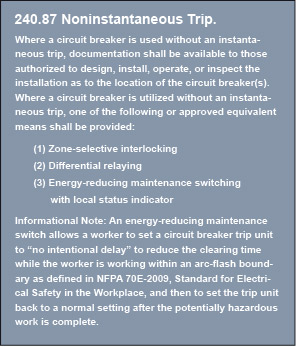
Figure 5. NEC-2011 language for Section 240-87, Noninstantaneous Trip
Energy Reducing Active Arc-Flash Mitigation Systems
A circuit breaker equipped with an energy reducing active arc-flash mitigation system provides a simple and reliable method to reduce fault clearing times. Work locations downstream of a circuit breaker with this technology can have a significantly lower incident energy level. When activated, this system monitors system parameters and acts to identify an arc flash. If an arc flash event occurs, the arc is diverted via various types of technology while opening an upstream circuit breaker, eliminating the faulted condition and de-energizing the system.
Approved Equivalent Means
Section 90.4 of the NEC has a provision for the authority having jurisdiction for enforcing the Code, to permit alternative methods to a requirement where it is assured that equivalent objectives can be achieved by establishing and maintaining effective safety. The phrase “or equivalent” is used 77 times in NEC 2011 with some instances being much more clear cut than others. The phrases “approved equivalent means” and “or equivalent” can be quite controversial in some instances when the inspector is being presented with a design that doesn’t meet the letter of the code but is being asked to be considered as equivalent. Inspectors across the country probably have those top two or three examples that they see all the time and have their dialog down pat when presented with the “equivalent” design. Section 240.87 offers another example of this but the answer can be quite clear.
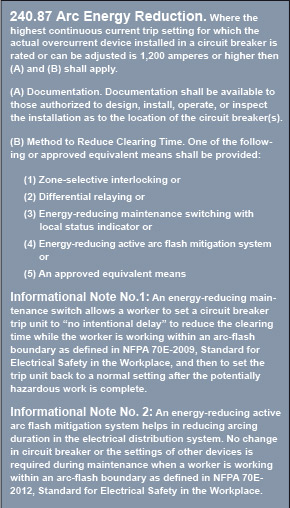
Figure 6. NEC 2014 Section 240.87
Before an inspector evaluates a proposed equivalent means, we must first understand the intent of this section of the Code. The new title change helps considerably with this as it clearly states that it is there for “Arc Energy Reduction.” The inspector can make his/her job very transparent when approving an equivalent means. The first step is to request the results of an arc flash study for one of the four listed options and the results of an arc flash study with the proposed equivalent means. This yields two arc flash numbers that can be compared. The proposed equivalent means shall be considered “approved” when the arc flash value for the proposed equivalent means is equal to or less than the arc flash value calculated for one of the four listed technologies.
The inspector does not have to perform a calculation, read a TCC curve or any of the literature for a breaker or other type of system being offered as an equivalent means. Keep it simple. Ask for two arc flash values as described above and compare the numbers. It’s that simple.
Parting Remarks
NEC 2014 Section 240.87 is a historical code change and one of the most important leaps in arc flash safety for the electrical industry. This new language, through my eyes, will take a bite out of the arc flash issue and save lives. As we come closer to the annual meeting in Chicago for the final stages of NEC 2014, stay tuned for the final agreed upon language. Together we can make a difference.
As always, keep safety at the top of your list and ensure you and those around you live to see another day.
References
1IEEE Std. 1584-2002 “IEEE Guide for Performing Arc-Flash Hazard Calculations”











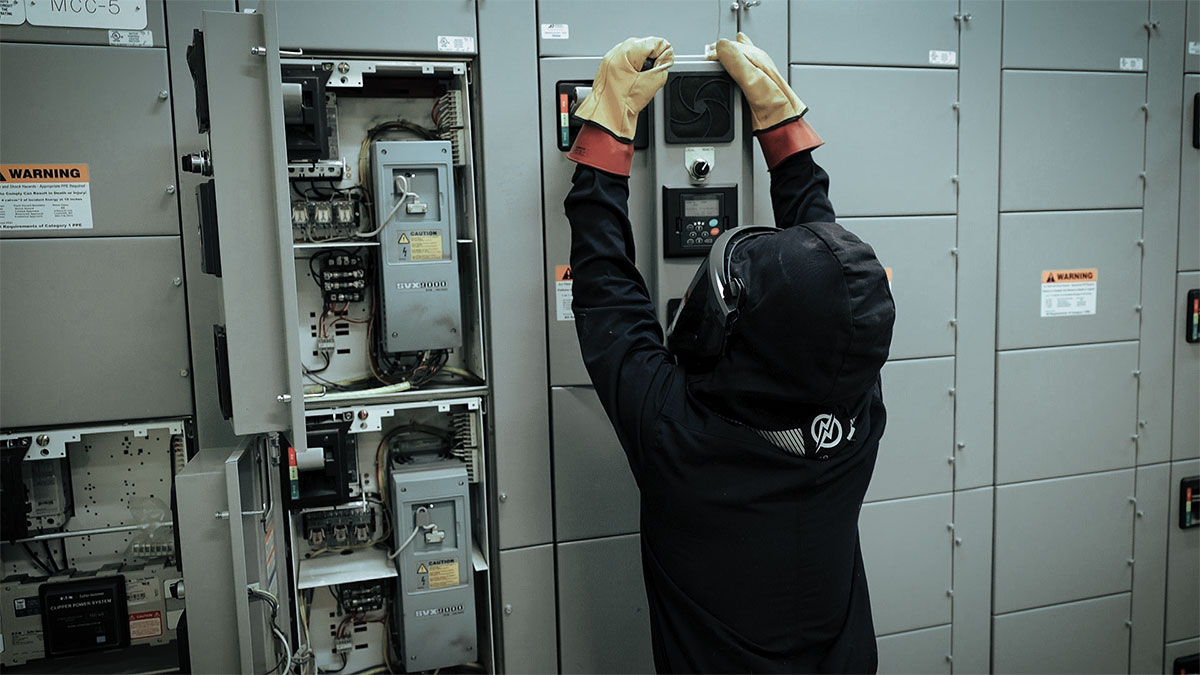


Find Us on Socials